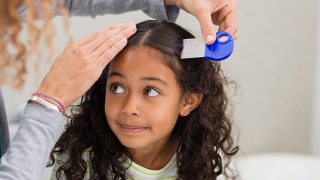Head Lice: The Latest on Treating Lice and Stopping Their Spread
Published on
Health Tip of the WeekPublished on
Health Tip of the Week Your child comes home from school scratching at an itchy scalp. Could it be? Surely not your child, right? There’s no way someone in your family could have … head lice!
Your child comes home from school scratching at an itchy scalp. Could it be? Surely not your child, right? There’s no way someone in your family could have … head lice!
Before you panic, keep in mind that lice and their eggs, called nits, are more of a nuisance than a health concern.
“Even though the mere mention of the word ‘lice’ makes everyone itchy, the tiny bugs do not carry any disease,” says Naline Lai, MD, FAAP, a pediatrician at Children’s Hospital of Philadelphia’s Primary Care location in Doylestown, PA, and co-founder of the Two Peds in a Pod blog.
And having head lice is not an indication of a lack of personal hygiene. The critters don’t discriminate so anyone, anywhere, can get them.
Thankfully, lice crawl — not jump, hop or fly — which means they typically spread through close, prolonged and head-to-head contact, according to the American Academy of Pediatrics (AAP). Yes, there’s a chance that head lice will spread if kids share personal items like a hat or a comb, but it’s very small.
So, what should (and shouldn’t!) you do to stop the spread of lice?
To check your child’s head for lice, you should start by sitting them in a brightly lit room. Part their hair so you can take a close look at the scalp. Spotting live lice can be difficult, because they’re fast and avoid light. Nits, though, look like small white or yellow-brown specks and will be attached firmly to the hair shaft, near the scalp.
If your child has lice, the easiest place to spot the nits will be at the hairline on the neck or behind the ears. You can also wet your child’s hair then run a fine-toothed comb through the hair, wipe the comb on a wet paper towel, and then carefully examine the towel for lice or nits.
The best way to treat head lice is with a medication that’s designed specifically for the treatment of lice. There are several over-the-counter options, just be sure to follow all directions carefully. You may also need to repeat the treatment to completely get rid of lice, but be sure to check with your child's pediatrician before beginning a second or third course.
Over time, insects do develop resistance to certain products, which is why you may have heard about lice that are resistant to some over-the-counter medications. The actual prevalence of medication-resistant lice hasn’t been confirmed, though, and can vary from one part of the country to another.
If your child’s lice isn’t going away after you’ve tried a few rounds of an OTC medication, it may be time to try one of the approved prescription medications.
Since the American Academy of Pediatrics (AAP) updated its guidance on the management of lice in school in 2015, many schools have moved away from “no nit” policies that prevented students from returning to school. According to the AAP, children do not need to leave school early or miss school because of head lice.
“Since having lice is not an emergency, even if live lice are found crawling in a child’s head, children can wait until the end of the school day to be referred for treatment and return to school once they’ve been treated,” says Julie Kardos, MD, a pediatrician at CHOP Primary Care, Newtown, and the other cofounder of Two Peds in a Pod.
That said, children who have been treated for lice should be discouraged from head-to-head contact with other children.
If your child is treated for head lice, there’s no need to get rid of their belongings or spray pesticides in your home (these can be dangerous and expose your family to unnecessary chemicals).
You should wash all bedding and clothing your child used during the three days prior to lice being found in hot water (130 degrees F or 54 degrees C) and dry them on high heat. For items that cannot be washed, consider sealing them in a plastic bag for two weeks to ensure all lice and nits are dead.
You should also check all household members and anyone else who has had close contact with your child and have them treated for lice if necessary.
Listen to Primary Care Perspectives: What to Know About Lice/Scabies in the Primary Care Setting, a podcast by CHOP physicians.
Contributed by: Naline Lai, MD, FAAP, Julie Kardos, MD, FAAP
Categories: Head lice
Are you looking for advice to keep your child healthy and happy? Do you have questions about common childhood illnesses and injuries? Subscribe to our Health Tips newsletter to receive health and wellness tips from the pediatric experts at Children's Hospital of Philadelphia, straight to your inbox. Read some recent tips.